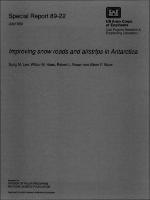Please use this identifier to cite or link to this item:
https://hdl.handle.net/11681/12105| Title: | Improving snow roads and airstrips in Antarctica |
| Authors: | National Science Foundation (U.S.). Division of Polar Programs Lee, Sung M. Haas, Wilbur M. Brown, Robert L. (Robert Lee), 1939- Wuori, Albert F. |
| Keywords: | Aircraft skiway Snow roads Antarctica Snow Runways EPOLAR |
| Publisher: | Cold Regions Research and Engineering Laboratory (U.S.) Engineer Research and Development Center (U.S.) |
| Series/Report no.: | Special report (Cold Regions Research and Engineering Laboratory (U.S.)) ; 89-22. |
| Description: | Special Report Abstract: During the 1986-1987 austral summer, snow road and runway test lanes were constructed at McMurdo Station and at South Pole Station. These lanes were monitored during December 1986, January 1987, and again in January 1988. Test sections were constructed of 1) tractor-compacted snow topped with a 15-cm thick layer of rotary blower processed snow, 2) rotary processed and compacted snow in 15-cm layers to a depth of 60 cm, 3) rotary processed and compacted snow in 15-cm layers incorporating a wood sawdust additive mixed at 5% by volume, and 4) rotary-processed snow with 10% sawdust by volume. These test sections were observed and monitored by obtaining temperature and density profiles, Rammsonde hardness profiles, California Bearing Ratio and Clegg surface strength values, and testing for ability to withstand traffic. It was concluded that wood sawdust added to processed snow in amounts of 5% to 10% by volume significantly increases the strength of the resulting snow road or runway. This increase was greater at McMurdo than at the South Pole, appearing to be a function of snow temperature. Adequate strengths of the snow/sawdust mixtures were achieved for limited use by wheeled C130 aircraft, but additional processing with heat, water or added compaction appears necessary to produce a 25-cm-thick surface layer adequate for more frequent use and to accommodate wheeled C141 aircraft. At McMurdo, it was found that the sawdust was not effective in maintaining the integrity of the surface for traffic during the thawing season without additional maintenance, whereas at the South Pole, thawing was not a problem since temperatures remained well below the melting point. It was concluded that the McMurdo snow roads were not constructed adequately early in the season to prevent failure and, therefore, required an unduly high maintenance effort during the warm season. It is recommended that the future roads be constructed by depth processing with a rotary miller or blower. It is also recommended that geotextile fabrics or membranes be used to divert water into culverts, and that the use of heat (or water) injection or confined dynamic compaction be investigated for creating a hard snow surface layer for use by C141 wheeled aircraft. |
| Rights: | Approved for Public Release. Distribution is Unlimited. |
| URI: | http://hdl.handle.net/11681/12105 |
| Appears in Collections: | Special Report |
Files in This Item:
| File | Description | Size | Format | |
|---|---|---|---|---|
| SR-89-22.pdf | 5.4 MB | Adobe PDF |  View/Open |